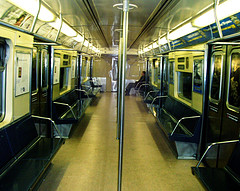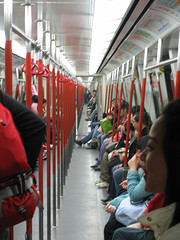A couple of years back I attended a conference where somebody– I think it was a couple of Chicago payrollers– reported on the bus rapid transit system of Curitiba, Brazil. It’s considered by many (and I have no information to the contrary) to be a cost-effective implementation of pretty good transit service (better than we have, anyhow) at modest cost. They actually got to compare notes with the former Mayor who is considered most responsible for the design of the system. He was quoted as saying, “I’m glad we don’t have as much money as you have in Chicago, because surely we would waste it.”
What reminded me of this most recently is this release from Sen. Durbin’s office, anouncing or reannouncing the awarding of various grants. In particular:
Illinois Department of Transportation (Chicago Metro): $341,694 in TIGGER II funding to install automatic shut-down and start-up systems in an estimated 27 locomotives in the Metra fleet, which operates in the Chicago metro area. Metra estimates that by shutting down instead of idling the locomotives, the automatic systems could save an estimated 800,000 gallons of diesel fuel and reduce CO2 emissions by an estimated 80,000 tons per year.
If the information is to be believed, an investment of $341,694 “could save” 800,000 gallons of diesel per year. Now, I don’t know how reliable that estimate is, but let’s assume it’s way too high, really only 200,000 gallons will be saved. And what does Metra pay for diesel, surely not less than $2.50/gallon. On these very conservative assumptions, it would take less than 9 months’ fuel savings to pay for the devices. (And that’s not even considering the savings from not having to go thru the grant process.) And if they lacked the cash, they certainly could have borrowed it, paid extortionate interest, and still come out ahead in a year.
So why didn’t Metra do that? Are they stupid? Or corrupt? Of course I have no way to know, but I think there’s another reason. I can imagine how the decision was made:
Technical staffer: We can buy shutoff devices, pay for them with fuel savings in less than a year. May I place the order?
Manager: Would this qualify for TIGGER funds?
TS: Huh?
M: It’s a grant program. I don’t remember where the acronym comes from, but it’s federal money we can spend on things that save energy and reduce emissions. This sounds like it would qualify. The Board prefers that we use federal money instead of Metra’s “own” money.
TS: I suppose it would qualify. What do I do now?
M: Go talk to the Metra Department of Getting Grants. They’ll take care of it, you’ll just have to get them some pictures, brochures, maybe some other paper. Shouldn’t take you more than a week or two.
TS: Well, OK. Will I get a bonus for this?
I have no idea who will get a bonus, but I know who is spending more and waiting longer than necessary for a cost-effective investment.


